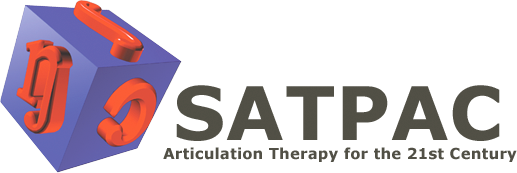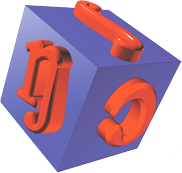Computerized Program for Articulation Therapy
December 6, 2011 6:04 pm
![]() for Speech-Language Pathologists & Audiologists
for Speech-Language Pathologists & Audiologists
February 11, 2002 – Page 11
By Stephen Sacks, MA, CCC-SLP
Students are making rapid progress in articulation therapy with a unique computerized program in the Fresno Unified School District (FUSD) in Fresno, CA. All speech-language pathologists have the SATPAC (Systematic Articulation Treatment Program Accessing Computers) program on their laptop computers and take it with them as they travel to their different school sites.
SATPAC, which has been in the works since 1994, was released last year.
“It’s been a tremendous time saver.” said Chae Gagnebin “I can print out lists for each student’s exact needs whenever I need them.”
I was one of the developers of SATPAC, having been inspired during a 1994 conference presentation by Richard Shine, EdD, of East Carolina University in Greenville, NC. Based on the work of Eugene McDonald and the McDonald Deep Test of Articulation, Dr. Shine had developed a series of lists, that moved from facilitating contexts to normal production.
For example, using the word “beetseek” for a frontal lisp, the /t/ assists in correct /s/ production at the syllable juncture. The other sounds also work together to aid in making the correct production. The /s/ sound is established, generalized and transferred all with the use of lists in the program. Sounds not within the student’s repertoire can be excluded as well as sounds which interfere with the target (e.g., /th/).
I was very impressed by Dr. Shine’s system and the FUSD Speech Department made a commitment to use this list system to remediate articulation problems. However, it soon became clear that it was not practical. It took up to two hours to handwrite the lists for one student. Due to high caseloads and little time, the project was abandoned.
With the collaboration of Bob Alei, a computer program developer, a home version of SATPAC was created.
The turning point in developing a functional program for widespread use came in 1995 when new student transferred to the school. He was 8 years old, had been in speech since he was 4 and was totally unintelligible. He had almost all the major phonological processes: he stopped, fronted, glided and deleted initial and final consonants . After 30 sessions using the SATPAC program, he was highly intelligible and used all sounds in conversational speech except for /th/, which hadn’t been targeted.
During the next five years, the SATPAC program continued to develop and evolve. In 2000 speech-language pathologists at FUSD began using it. The reaction among therapists who use the program has been positive.
Specialist Carl D’Souza noticed that the program’s rhythmic nature and rapid rate using a metronome while saying the bisyllable led to more time on task with increased focus. Words from lists are modeled for the student and then repeated.
“Having the kids say the words from the computer is motivating for them, too” he said. “It is not unusual to get 200 correct responses during a therapy session.”
“Because SATPAC is systematic and stresses coarticulation from the earliest phases, students meet their goals very quickly. My dismissal rate has increased significantly since implementing SATPAC.”
The FUSD Speech/Language Administration also gives SATPAC high marks. Program Manager Kathleen Scott observed that students stay on task much better than with traditional articulation therapy, adding, “Through the use of SATPAC, I was able to see students make growth within a 25-minute period. “SATPAC is a real plus in our program,” agreed Lindsey Sutherland, Designated Instructional Services Coordinator at FUSD noted that, “It reduces overall time that students spend in therapy and that is significant with our large caseloads.”
Using traditional therapy materials in commercial programs has always been frustrating. One of my pet peeves using prepared materials is that there are always sounds in the words which the student cannot say or actually hinder correct productions. For example, there is a popular book that has 20 drawings per page. For a target sound of /k/ there are words like “cat,””coat,””kite,” etc. I have found that I have to avoid these words with a student who has the phonological process of fronting. However, with SATPAC I can make word lists without the /t,d/ sounds allowing the student the opportunity to focus solely on the target sound and develop the quick motor responses needed to say the sound correctly.
Procedurally, an appropriate CVCCVC word like “beetseek” is chosen to target the /s/ sound. The student must establish the word with 95% accuracy through 7 different lists. Then the sound is generalized through eight lists of 20 different words, each list moving farther and farther away from the facilitating context.
With the use of a metronome, students must say each syllable at 140 beats per minute before moving on to the next list. Practicing at a conversational rate is critical to success. If the practice is too slow, it doesn’t transfer. The metronome allows the therapist to know exactly at what rate the student can say the word.
When the student is near the end of the generalization phase, sentences are produced using varying prosodic stress. This simulates normal conversation where the emphasis in not necessarily on the targeted speech sound. For example, the student will say, “The boy bought a new beetseek,” “The boy bought a new beetseek,” “The boy bought a new beetseek,” etc. Success using the target sound in sentences with varying prosodic stress leads to faster transfer into conversational speech.
After target sounds are generalized, they are transferred into phrases and sentences. SATPAC comes with these materials and 100 target sounds in each list for each sound making it easy to baseline performance. The final portion of the program involves contrasting the target sound with various problem sounds. For example, for the student who used to front the /k,g/ sounds, sentences are given which include the /t, d, k, g/ sounds. Final transfer involves conversation and/or using classroom material to be read and discussed.
I recently met with McDonald to show him how his ideas and techniques had been expanded and applied to the computer. He stated that the program “‰Û_skillfully builds on my program of sensorimotor therapy. Its well-organized steps will be effective in remediating articulatory defects.”
What started as a one-year project turned into more than 5000 hours of work and six years of waiting. Through trial and error and feedback from speech-language pathologists using various evolving experimental versions, the current version of SATPAC was developed.
It’s thrilling to hear from other speech-language pathologists who are experiencing the same excitement I initially felt when I saw my students rapidly developing normal speech.
For more information contact Stephen Sacks at info@satpac.com or https://satpac.com/
Copyright å©2004 Merion Publications 2900 Horizon Drive, King of Prussia, PA 19406 ‰Û¢ 800-355-5627 Publishers of ADVANCE Newsmagazines www.advanceweb.com
This article was published by ![]() for Speech-Language Pathologists & Audiologists
for Speech-Language Pathologists & Audiologists
February 11, 2002 – Page 11



